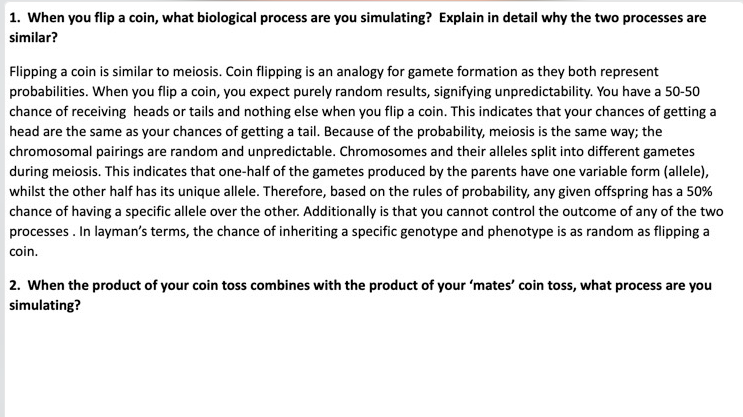Biology: The Dynamic Science (MindTap Course List)
4th Edition
ISBN:9781305389892
Author:Peter J. Russell, Paul E. Hertz, Beverly McMillan
Publisher:Peter J. Russell, Paul E. Hertz, Beverly McMillan
Chapter11: Meiosis: The Cellular Basis Of Sexual Reproduction
Section: Chapter Questions
Problem 12TYK: Discuss Concepts One of the human chromosome pairs carries a gene that influences eye color. In an...
Related questions
Question
(grade 11 biology)
When the product of your coin toss combines with the product of your ‘mates’ coin toss, what process are you simulating?

Transcribed Image Text:1. When you flip a coin, what biological process are you simulating? Explain in detail why the two processes are
similar?
Flipping a coin is similar to meiosis. Coin flipping is an analogy for gamete formation as they both represent
probabilities. When you flip a coin, you expect purely random results, signifying unpredictability. You have a 50-50
chance of receiving heads or tails and nothing else when you flip a coin. This indicates that your chances of getting a
head are the same as your chances of getting a tail. Because of the probability, meiosis is the same way; the
chromosomal pairings are random and unpredictable. Chromosomes and their alleles split into different gametes
during meiosis. This indicates that one-half of the gametes produced by the parents have one variable form (allele),
whilst the other half has its unique allele. Therefore, based on the rules of probability, any given offspring has a 50%
chance of having a specific allele over the other. Additionally is that you cannot control the outcome of any of the two
processes . In layman's terms, the chance of inheriting a specific genotype and phenotype is as random as flipping a
coin.
2. When the product of your coin toss combines with the product of your 'mates' coin toss, what process are you
simulating?
Expert Solution
This question has been solved!
Explore an expertly crafted, step-by-step solution for a thorough understanding of key concepts.
This is a popular solution!
Trending now
This is a popular solution!
Step by step
Solved in 2 steps

Knowledge Booster
Learn more about
Need a deep-dive on the concept behind this application? Look no further. Learn more about this topic, biology and related others by exploring similar questions and additional content below.Recommended textbooks for you

Biology: The Dynamic Science (MindTap Course List)
Biology
ISBN:
9781305389892
Author:
Peter J. Russell, Paul E. Hertz, Beverly McMillan
Publisher:
Cengage Learning

Biology 2e
Biology
ISBN:
9781947172517
Author:
Matthew Douglas, Jung Choi, Mary Ann Clark
Publisher:
OpenStax

Biology: The Unity and Diversity of Life (MindTap…
Biology
ISBN:
9781337408332
Author:
Cecie Starr, Ralph Taggart, Christine Evers, Lisa Starr
Publisher:
Cengage Learning

Biology: The Dynamic Science (MindTap Course List)
Biology
ISBN:
9781305389892
Author:
Peter J. Russell, Paul E. Hertz, Beverly McMillan
Publisher:
Cengage Learning

Biology 2e
Biology
ISBN:
9781947172517
Author:
Matthew Douglas, Jung Choi, Mary Ann Clark
Publisher:
OpenStax

Biology: The Unity and Diversity of Life (MindTap…
Biology
ISBN:
9781337408332
Author:
Cecie Starr, Ralph Taggart, Christine Evers, Lisa Starr
Publisher:
Cengage Learning